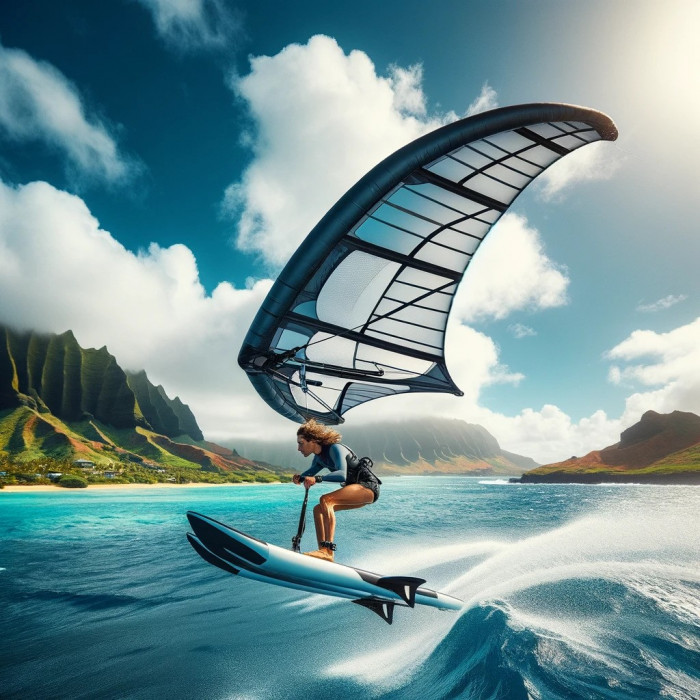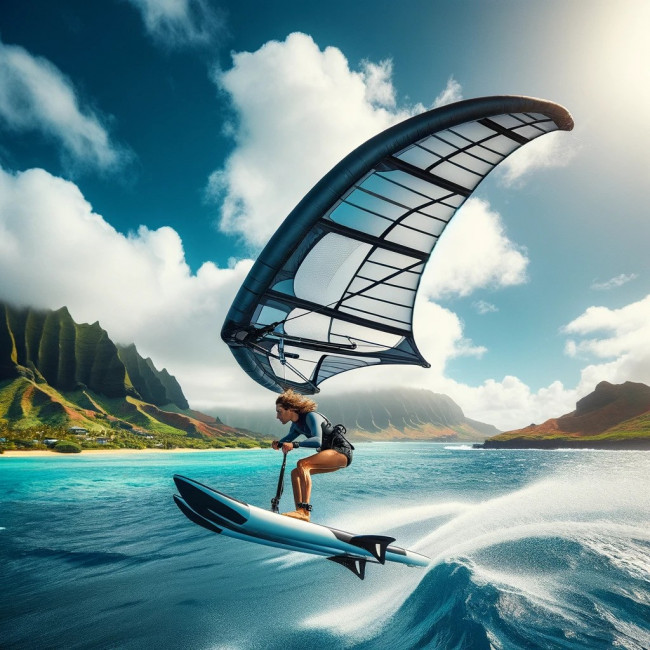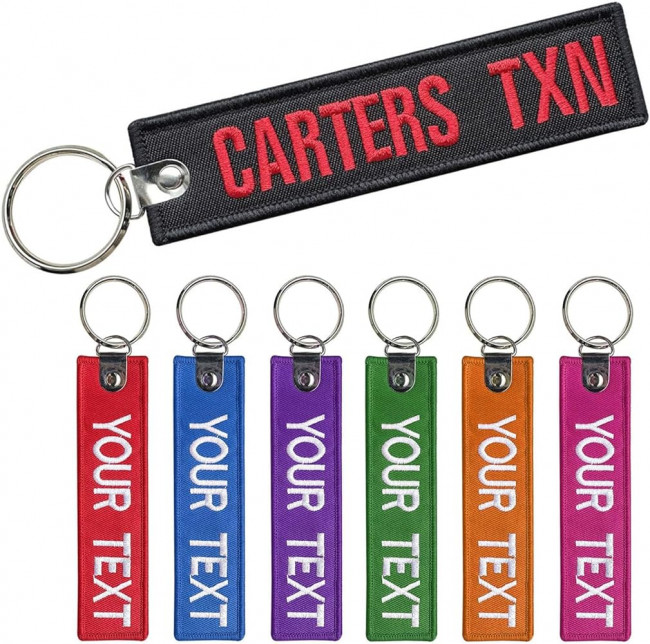Wing foil surfing, a relatively new water sport, has taken the world by storm with its unique blend of surfing, windsurfing, and kiteboarding. It involves riding a foil board while holding onto a handheld wing, allowing riders to harness the power of the wind and glide across the water's surface with exhilarating speed and control.
The Rising Trend of Wing Foil Surfing in Hawaii
Hawaii, renowned for its stunning beaches and perfect waves, has become a hotspot for wing foil surfing enthusiasts. The islands' consistent trade winds and diverse coastline offer ideal conditions for this thrilling sport, attracting riders from across the globe to experience the ultimate adrenaline rush on the waves.

Essential Equipment for Wing Foil Surfing
Wing
The wing is the primary piece of equipment in wing foil surfing, resembling a large kite or sail. It captures the wind's power, propelling riders forward and allowing them to maneuver across the water with precision. Wings come in various sizes to suit different wind conditions and rider preferences.
Foil Board
The foil board, also known as a hydrofoil board, features a streamlined design with a mast and hydrofoil attached to the bottom. This innovative setup enables the board to lift out of the water as speed increases, reducing drag and providing a smooth, gliding sensation. Foil boards come in different shapes and sizes to accommodate riders of all skill levels.
Foil
The foil, or hydrofoil, is a specialized attachment that sits beneath the foil board's surface. It consists of a mast, fuselage, and wings, which work together to lift the board out of the water and maintain stability during flight. Foils vary in size and configuration, allowing riders to customize their setup based on their riding style and preferences.
Safety Gear
Safety should always be a top priority when engaging in wing foil surfing. Essential safety gear includes a well-fitted wetsuit or rash guard to protect against abrasions and sun exposure, as well as a helmet to safeguard against head injuries. Additionally, a leash attached to the foil board can prevent the board from drifting away in case of a fall.
Factors to Consider When Choosing Wing Foil Surfing Equipment
Skill Level
When selecting wing foil surfing equipment, consider your skill level as a rider. Beginners may benefit from larger wings and stable foil boards, which offer increased stability and forgiveness during the learning process. As you progress, you can transition to smaller wings and more responsive foils to enhance maneuverability and performance on the water.
Local Conditions
The conditions at your local surfing spot play a significant role in determining the most suitable equipment. Hawaii's diverse coastline offers a range of conditions, from calm bays to challenging surf breaks. Consider factors such as wind strength, wave height, and water depth when choosing your wing size, foil setup, and board shape.
Budget
Wing foil surfing equipment varies in price depending on the brand, quality, and features. Set a budget that aligns with your financial resources and invest in high-quality gear that offers durability and performance. While it's tempting to opt for cheaper options, investing in reliable equipment can enhance your enjoyment and safety on the water in the long run.
Popular Brands and Models of Wing Foil Surfing Equipment
Several reputable brands specialize in wing foil surfing equipment, offering a wide range of wings, foil boards, and foils to suit different preferences and riding styles. Some popular brands include:
- Duotone
- Naish
- Slingshot
- Cabrinha
- F-One
Each brand offers a variety of models with unique features and specifications, allowing riders to find the perfect setup for their needs.
Where to Buy Wing Foil Surfing Equipment in Hawaii
Hawaii boasts numerous surf shops and water sports retailers where you can purchase wing foil surfing equipment. Additionally, many online stores offer a convenient option for browsing and purchasing gear from the comfort of your home. Some popular retailers in Hawaii include:
- - PakaaFoilHawaii.com
Be sure to visit multiple stores or browse online to compare prices, explore available options, and seek expert advice from knowledgeable staff members.
Tips for Beginners in Wing Foil Surfing
Take Lessons
Before hitting the water on your own, consider taking lessons from certified instructors. Professional instruction can accelerate your learning curve, teach you proper technique, and ensure your safety on the water. Many water sports schools and surf shops in Hawaii offer wing foil surfing lessons tailored to beginners.
Start in Calm Conditions
When starting out in wing foil surfing, choose calm weather conditions with light winds and small waves. This allows you to focus on mastering the basics without being overwhelmed by challenging conditions. As you gain confidence and proficiency, you can gradually progress to more challenging environments.
Practice Balance
Balance is crucial in wing foil surfing, as you'll need to maintain stability while riding the foil board and controlling the wing. Practice balance exercises on land, such as standing on a balance board or stability ball, to improve your stability and coordination. As you become more comfortable, practice balancing on the foil board in shallow water before attempting to ride waves.
Maintenance and Care of Wing Foil Surfing Equipment
Proper maintenance and care of your wing foil surfing equipment are essential for prolonging its lifespan and ensuring optimal performance. Here are some maintenance tips to keep your gear in top condition:
Cleaning
After each session, rinse your equipment thoroughly with fresh water to remove saltwater, sand, and debris. Pay particular attention to the foil components, ensuring they are free from corrosion and buildup. Use mild soap and a soft brush to gently scrub any stubborn dirt or grime, then rinse thoroughly and allow to air dry before storing.
Storage
Proper storage is crucial for protecting your wing foil surfing equipment from damage and degradation. Store your gear in a cool, dry place away from direct sunlight and extreme temperatures. Hang your wings to dry completely before storing to prevent mold and mildew growth. Additionally, store your foil board and foil components in padded bags or protective covers to prevent scratches and dings during transportation and storage.
Repairs
Regularly inspect your wing foil surfing equipment for signs of wear and damage, such as cracks, dents, or loose fittings. Address any issues promptly to prevent further damage and ensure safe operation on the water. Many minor repairs, such as patching small tears in wings or tightening loose screws on foils, can be performed at home with basic tools and materials. For more extensive repairs or maintenance tasks, seek assistance from a professional repair technician or the manufacturer.
Safety Precautions for Wing Foil Surfing
Safety should always be a top priority when engaging in wing foil surfing. Follow these safety precautions to minimize the risk of accidents and injuries:
Weather Conditions
Before heading out on the water, check the weather forecast and wind conditions to ensure they are suitable for wing foil surfing. Avoid venturing out in stormy or excessively windy conditions, as these can pose a danger to your safety. Pay attention to changing weather patterns and be prepared to return to shore if conditions deteriorate unexpectedly.











